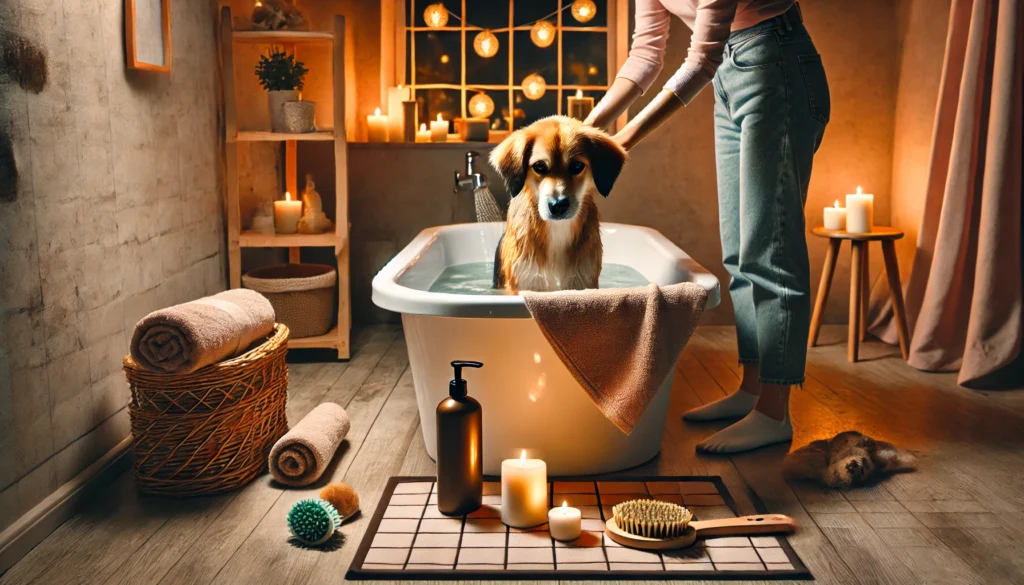Bath time can be a challenging experience for both dogs and their owners. Some dogs enjoy water, while others may feel anxious or uncomfortable. However, with the right preparation and approach, you can make bath time a more enjoyable and stress-free experience for your dog. Here’s a comprehensive guide on how to prepare, bathe, and care for your dog to ensure they stay clean and comfortable.
Preparing for Bath Time
Proper preparation is essential to make bath time smooth and efficient. Setting up the bath area, gathering supplies, and understanding your dog’s needs can help prevent stress and make the experience more enjoyable.
1. Gather All Necessary Supplies
Having everything you need within reach prevents interruptions and allows you to focus on keeping your dog calm.
- Dog Shampoo: Use a mild, dog-specific shampoo to avoid skin irritation. Avoid human shampoos as they can disrupt a dog’s pH balance.
- Conditioner: For dogs with long or dry coats, a dog-friendly conditioner can keep their fur soft and manageable.
- Brush: Brush your dog’s fur before the bath to remove tangles and loose hair.
- Towels: Have at least two towels—one for drying your dog after the bath and one for placing on the floor to prevent slipping.
- Non-Slip Mat: Place a rubber mat in the tub or sink to help your dog feel more secure.
2. Choose the Right Bathing Area
Choosing the right space for bathing depends on your dog’s size, temperament, and comfort level.
- For Small Dogs: A sink or portable pet tub may be more comfortable and easier to control.
- For Medium to Large Dogs: A bathtub or shower area with a handheld sprayer can offer more space.
- Outdoor Baths: For dogs who enjoy being outdoors, a garden hose can be used in warm weather, but be mindful of water temperature and pressure.
3. Check the Water Temperature
Water that is too hot or too cold can make bath time unpleasant. Use lukewarm water to ensure your dog feels comfortable.
- Warm, Not Hot: Water should feel warm but not hot to the touch. Dogs have sensitive skin, so always test the temperature first.
- Adjust as Needed: If you notice your dog reacting to the water, adjust the temperature to their preference.
Making the Bathing Experience Comfortable
Once everything is set up, focus on keeping your dog calm and comfortable during the bath. Talking gently, using soothing techniques, and bathing gradually can make a big difference.
1. Start Slowly and Gently
Begin by wetting your dog gradually, starting from their legs and working your way up to their back and head.
- Avoid Sudden Movements: Move calmly and avoid sudden sprays that may startle your dog.
- Head Last: Dogs are sensitive around the face, so leave the head and ears for last to reduce stress.
- Positive Reinforcement: Praise your dog throughout the bath and reward them with treats to create a positive association.
2. Use a Calm, Reassuring Voice
A soothing tone can help your dog relax and feel safe during the bath.
- Reassure and Encourage: Speak calmly to reassure your dog and let them know they’re doing well.
- Avoid Loud Noises: Bath time should be quiet and peaceful. Avoid turning on loud taps or using high-pressure hoses.
3. Be Careful Around Sensitive Areas
Dogs have sensitive areas like their eyes, ears, and nose, which should be handled carefully to avoid discomfort.
- Ears: Avoid getting water inside your dog’s ears, as it can lead to infections. Use a washcloth to gently clean around the ear area.
- Eyes: Rinse carefully around the eyes and use a gentle touch. Avoid getting shampoo in their eyes.
- Tail and Paws: Some dogs are sensitive around their paws and tail. Be gentle and take your time cleaning these areas.
Rinsing and Drying
Rinsing thoroughly and drying your dog properly are essential steps to avoid irritation and ensure a positive experience.
1. Rinse Thoroughly
Leaving shampoo residue on your dog’s skin can cause itching and discomfort, so ensure all shampoo is rinsed out completely.
- Rinse Until Water Runs Clear: Continue rinsing until there are no signs of suds or soap residue.
- Check Hard-to-Reach Areas: Pay extra attention to the underside, belly, and between the legs.
2. Towel Dry First
Once your dog is rinsed, use a towel to remove most of the water. Gently pat their coat to absorb excess moisture.
- Pat, Don’t Rub: Rubbing vigorously can tangle fur and cause discomfort. Instead, gently pat dry.
- Use Multiple Towels if Needed: For long-haired or large dogs, you may need more than one towel.
3. Use a Low-Heat Dryer (Optional)
If your dog is comfortable with it, a pet-safe dryer on a low-heat setting can help speed up the drying process, especially for dogs with thick coats.
- Low and Cool Settings: Use low or cool settings to avoid overheating your dog.
- Introduce Gradually: If your dog is unfamiliar with the dryer, introduce it slowly and keep it at a distance.
- Alternative Air Drying: For dogs who dislike dryers, you can let them air dry in a warm, draft-free room.
After-Bath Care
After the bath, a few additional steps can help keep your dog comfortable and maintain a fresh, clean coat.
1. Brush and Groom
Brushing after a bath helps remove any remaining loose fur and keeps your dog’s coat tangle-free.
- De-Shedding Tools: For dogs that shed heavily, use a de-shedding brush to remove loose fur.
- Regular Grooming: Regular brushing also distributes natural oils, keeping the coat shiny and healthy.
2. Reward and Praise
A positive experience ends with rewards and praise. This reinforces the behaviour and helps your dog associate bath time with pleasant memories.
- Treats and Affection: Offer treats and pet your dog to reinforce positive behaviour.
- Playtime: Follow up with a favourite toy or a gentle play session to help your dog relax.
3. Clean the Bathing Area
Keeping the bath area clean prevents slipping hazards and maintains hygiene for future baths.
- Rinse and Sanitize: Rinse any shampoo or hair from the tub or sink.
- Store Supplies: Put away all supplies in a designated area for easy access next time.
Tips for Reducing Bath Time Anxiety
If your dog shows signs of anxiety during baths, here are some additional tips to help them feel more comfortable:
- Introduce Baths Gradually: Allow your dog to explore the bathing area before starting, so they can feel at ease.
- Use Bath Mats: Non-slip bath mats provide stability, reducing the risk of slipping and calming nervous dogs.
- Bath Toys: Some dogs respond positively to bath toys, which can make the experience more engaging.
Conclusion: Creating a Stress-Free Bathing Routine
With patience, preparation, and a gentle approach, bath time can become a more pleasant experience for both you and your dog. By following these steps, you’ll help keep your dog clean and comfortable, building positive associations with bath time. With regular practice and positive reinforcement, your dog may even come to look forward to their baths.

Meet Claudia Boaski, an enthusiast in pet care, plants, and home wellness. She is dedicated to helping people create harmonious and welcoming homes, fostering a deep connection with nature and their furry companions.







